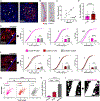Focal clusters of peri-synaptic matrix contribute to activity-dependent plasticity and memory in mice
- PMID: 38676925
- PMCID: PMC11251421
- DOI: 10.1016/j.celrep.2024.114112
Focal clusters of peri-synaptic matrix contribute to activity-dependent plasticity and memory in mice
Abstract
Recent findings show that effective integration of novel information in the brain requires coordinated processes of homo- and heterosynaptic plasticity. In this work, we hypothesize that activity-dependent remodeling of the peri-synaptic extracellular matrix (ECM) contributes to these processes. We show that clusters of the peri-synaptic ECM, recognized by CS56 antibody, emerge in response to sensory stimuli, showing temporal and spatial coincidence with dendritic spine plasticity. Using CS56 co-immunoprecipitation of synaptosomal proteins, we identify several molecules involved in Ca2+ signaling, vesicle cycling, and AMPA-receptor exocytosis, thus suggesting a role in long-term potentiation (LTP). Finally, we show that, in the CA1 hippocampal region, the attenuation of CS56 glycoepitopes, through the depletion of versican as one of its main carriers, impairs LTP and object location memory in mice. These findings show that activity-dependent remodeling of the peri-synaptic ECM regulates the induction and consolidation of LTP, contributing to hippocampal-dependent memory.
Keywords: CP: Cell biology; CP: Neuroscience; CS clusters; chondrotin sulfate proteoglycans; extracellular matrix; hippocampus; immunoprecipitation; learning and memory; sensory manipulation; synaptic plasticity; versican.
Copyright © 2024 The Authors. Published by Elsevier Inc. All rights reserved.
Conflict of interest statement
Declaration of interests The authors declare no competing interests.
Figures







Similar articles
-
Pyk2 in dorsal hippocampus plays a selective role in spatial memory and synaptic plasticity.Sci Rep. 2021 Aug 11;11(1):16357. doi: 10.1038/s41598-021-95813-x. Sci Rep. 2021. PMID: 34381140 Free PMC article.
-
Melanocortin-4 receptor regulates hippocampal synaptic plasticity through a protein kinase A-dependent mechanism.J Neurosci. 2013 Jan 9;33(2):464-72. doi: 10.1523/JNEUROSCI.3282-12.2013. J Neurosci. 2013. PMID: 23303927 Free PMC article.
-
The requirement of BDNF for hippocampal synaptic plasticity is experience-dependent.Hippocampus. 2016 Jun;26(6):739-51. doi: 10.1002/hipo.22555. Epub 2016 Jan 19. Hippocampus. 2016. PMID: 26662461 Free PMC article.
-
LTD, LTP, and the sliding threshold for long-term synaptic plasticity.Hippocampus. 1996;6(1):35-42. doi: 10.1002/(SICI)1098-1063(1996)6:1<35::AID-HIPO7>3.0.CO;2-6. Hippocampus. 1996. PMID: 8878740 Review.
-
Plasticity, hippocampal place cells, and cognitive maps.Arch Neurol. 2001 Jun;58(6):874-81. doi: 10.1001/archneur.58.6.874. Arch Neurol. 2001. PMID: 11405801 Review.
Cited by
-
Extracellular vesicles lay the ground for neuronal plasticity by restoring mitochondrial function, cell metabolism and immune balance.J Cereb Blood Flow Metab. 2025 Mar 12:271678X251325039. doi: 10.1177/0271678X251325039. Online ahead of print. J Cereb Blood Flow Metab. 2025. PMID: 40072028 Free PMC article. Review.
-
Early-life adversities compromise behavioral development in male and female mice heterozygous for CNTNAP2.Neurobiol Stress. 2025 Apr 22;36:100726. doi: 10.1016/j.ynstr.2025.100726. eCollection 2025 May. Neurobiol Stress. 2025. PMID: 40642450 Free PMC article.
-
Microglial depletion increases aggrecan and hyaluronan levels in the diffuse and aggregated extracellular matrix of the mouse brain.Sci Rep. 2025 Mar 18;15(1):9376. doi: 10.1038/s41598-025-94224-6. Sci Rep. 2025. PMID: 40102604 Free PMC article.
References
Publication types
MeSH terms
Grants and funding
- R35 GM144090/GM/NIGMS NIH HHS/United States
- R01 MH121102/MH/NIMH NIH HHS/United States
- S10 OD021651/OD/NIH HHS/United States
- R01 HD102974/HD/NICHD NIH HHS/United States
- R21 HD088931/HD/NICHD NIH HHS/United States
- R01 MH120991/MH/NIMH NIH HHS/United States
- R21 MH117609/MH/NIMH NIH HHS/United States
- R21 HD097524/HD/NICHD NIH HHS/United States
- R01 MH104488/MH/NIMH NIH HHS/United States
- R01 MH108665/MH/NIMH NIH HHS/United States
- R01 MH107487/MH/NIMH NIH HHS/United States
- P50 MH115874/MH/NIMH NIH HHS/United States
LinkOut - more resources
Full Text Sources
Medical
Molecular Biology Databases
Miscellaneous

